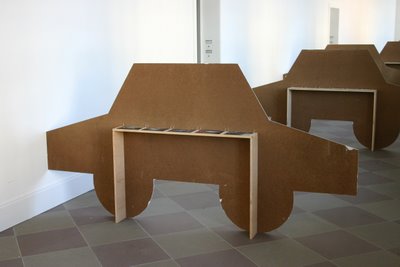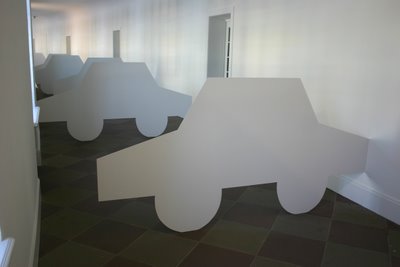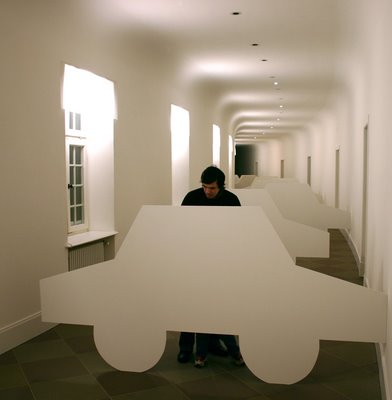






2006
installation
dimensions variable
Dream of Bucharest at Solitude
As in many other big cities, the situation of the cars in Bucharest is catastrophic. Not dissimilar to the cases of Moscow or Belgrade, the infrastructure of Bucharest has not greatly altered from the socialist times. From the end of Ceauşescu’s regime, 17 years ago, the number of cars has grown continuously each year, so that today there are 1 million cars for 2 million inhabitants! Like in many other cities, the urban landscape of Bucharest itself is affected by the sheer multitude of cars that can or cannot run and can or cannot park in a certain place. Vlad Nancă identifies with an obsession his birth place to the national Romanian car, Dacia 1300, built after the long forgotten Renault 12 at the beginning of the 70’s. Moreover, Vlad Nancă sees in Dacia the absolute metaphor of a society in stand by mode as it was in the time of Ceausescu: for 30 years Dacia 1300 was produced and sold without the slightest technical modification. In the post-socialist Bucharest, the new turbo capitalism with its huge adverts, its global brands of consumption and arrogant cars of the nouveau riche, this neoliberalism is thus confronted with the numerous traces left by the 30 years of political and economic idleness that Dacia so obviously embodies.
The works of Vlad Nancă are displayed predominantly in the public space, so they can seldom if at all be seen in art galleries. Both in Bucharest and outside he is known to be the promoter of a number of graffiti actions. Among other examples of this everywhere in Bucharest one can see car silhouettes that the artist has drawn in marker on walls, some of which can be seen in this exhibition.
In the installation »Dream of Bucharest«, the car becomes a ghostly factor of inconvenience (white on white) on the narrow corridor of Akademie Schloss Solitude: the 12 silhouettes of a white Dacia block the way obliging the viewer to walk around them as they do in Bucharest, where pedestrians have to make their way aside from the traffic and the parked cars. The guests and residents of Solitude can now share this dream, or rather nightmare of Bucharest. Behind each of the silhouettes Vlad Nancă displays photos, video material and sketches from his own notebooks. They are all recurrent motifs of his urban obsessions: the simplified profile of Dacia, the black balloon stamped with a terrorist figure on it, cars with their windscreen wipers up, like cut off wings of some mechanical birds and Maggi’s logo. All of these images and signs are remains of and references to previous projects that the artist drew or posted on pavements or walls. At the end of the corridor the artist can be seen drawing lots of Dacia silhouettes on a bridge behind Solitude castle. All of these are reiterated, obsessive gestures which replicate the automated production. Through his work Vlad Nancă denounces the aesthetic deficiency of the Romanian society generating this way some little and quiet inconveniences in the beautiful and well protected landscape of Akademie Schloss Solitude. The next stage of this creation and of other creations of Vlad Nancă will be at Galeria Nouă in Bucharest, a gallery that Solitude has collaborated with for the past two years.
Jean Baptiste Joly
Akademie Schloss Solitude, 25 January 2007
Dream of Bucharest
Labels:
2006,
installation
![]()